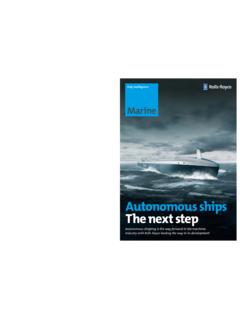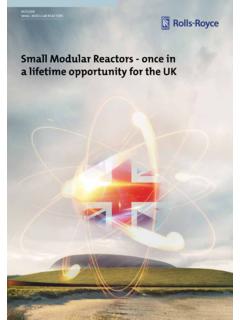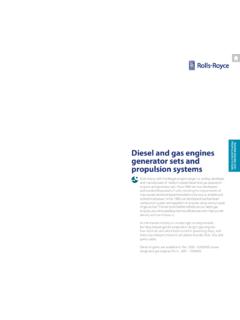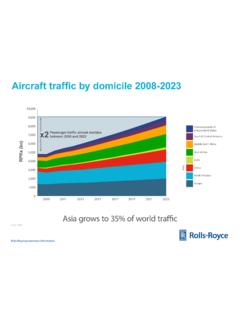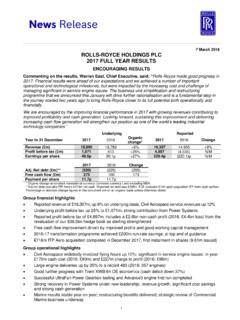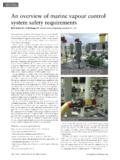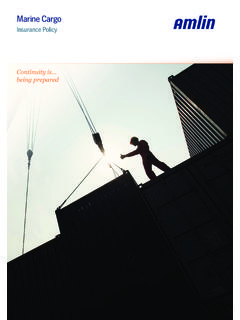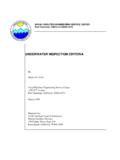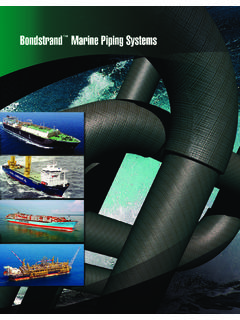Transcription of Remote and Autonomous Ships The next steps
1 Ship Intelligence Remote and Autonomous Ships The next stepsRemote and Autonomous Ship The next steps AAWA Position Paper Rolls-Royce plc Registered office: 62 Buckingham Gate, London, SW1E 6AT. Company number 1004142. Registered in England 2 TABLE OF CONTENTS Page Author(s) Introduction Background AAWA Initiative Vision of Remote controlled ship operation Voyage planning and initiation Unmooring and manoeuvring out of harbour Operation modes at open sea Port approach and docking Applicability for different ship types Conclusion 3 4 5 6 8 9 10 12 12 13 Esa Jokioinen Technologies for marine situational awareness and Autonomous navigation Autonomous navigation of the vessel Situational awareness (SA)
2 For Autonomous Ships Off-ship communication 15 18 23 30 Jonne Poikonen Mika Hyv nen Antti Kolu Tero Jokela Jari Tissari Ari Paasio Legal Implications of Remote and Autonomous shipping Introduction Law at sea Technical requirements Liability rules Summary 35 36 36 40 49 54 Henrik Ringbom Felix Collin Mika Viljanen Safety and security in Autonomous shipping challenges for research and development Introducing of Autonomous merchant Ships for maritime operation Are unmanned Ships safe? Preconditions of safety and security Focal areas of risk some selected examples Managing shipping safety and security in short and long term Building risk understanding for the future Recommendations 56 58 59 60 62 68 72 72 Risto Jalonen Risto Tuominen Mikael Wahlstr m From Innovations to Markets Redefining Shipping Redefining shipping a transition to Autonomous shipping Autonomous shipping an issue of business relationships and networks Autonomous shipping a renewed set of roles between the key actors Transition drivers to Autonomous shipping Transition roadmap Conclusion 74 75 77 79 80 82 85 Jouni Saarni Sini Nordberg-Davies Hannu Makkonen Remote and Autonomous Ship The next
3 steps AAWA Position Paper Rolls-Royce plc Registered office: 62 Buckingham Gate, London, SW1E 6AT. Company number 1004142. Registered in England 3 Introduction Esa Jokioinen Rolls-Royce Head of Blue Ocean Team Remote and Autonomous Ship The next steps AAWA Position Paper Rolls-Royce plc Registered office: 62 Buckingham Gate, London, SW1E 6AT. Company number 1004142. Registered in England 4 1. Background Autonomous shipping is the future of the maritime industry. As disruptive as the smart phone, the smart ship will revolutionise the landscape of ship design and operations Mikael Makinen, President Rolls-Royce Marine Ten years ago the very idea that you could manage your life through a small glass screen, was considered almost impossible.
4 Now few of us would want to be without one. Two years ago talk of intelligent Ships was considered by many as a futuristic fantasy. Today, the prospect of a Remote controlled ship in commercial use by the end of the decade is a reality. The technologies, particularly sensor technologies, needed to make Remote and Autonomous Ships a reality already exist. The challenge is to find the optimum way to combine them reliably and cost effectively. The decision algorithms which will help such vessels decide what action to take in the light of that sensor information are being perfected. This requires an interpretation of maritime rules and regulations leading to challenges of interpretation for the programmer.
5 The development of decision support systems will be a gradual and iterative process subject to extensive testing and simulation. To secure regulatory approval; as well as industry support and public acceptance, Remote and Autonomous Ships will need to be as least as safe as existing vessels. They have the potential to reduce human based errors but at the same time new types of risk will arise and will need to be addressed. A comprehensive and structured way to identify and address these risks is required. Unmanned Ships open up exciting possibilities to redefine the way a ship is designed and functions. When there are no people on board, many constraints on the ship layout are removed. One of the most obvious is the removal of the accommodation and with that the entire deckhouse.
6 This will save cost, weight and space, as well as enabling the ship to carry more cargo. A ship contains systems that are only there to serve the crew. Their removal will simplify the entire ship, which should improve reliability and productivity while reducing build and operating costs. Future vessels will still need human input from land making connectivity between the ship and the shore crucial. Such communication will need to be bidirectional, accurate, scalable and supported by multiple systems creating redundancy and minimising risk. Sufficient communication link capacity for ship sensor monitoring and Remote control, when necessary, has to be guaranteed. Continuous, guaranteed connectivity gives us the ability to monitor equipment in service in real time detecting, Remote and Autonomous Ship The next steps AAWA Position Paper Rolls-Royce plc Registered office: 62 Buckingham Gate, London, SW1E 6AT.
7 Company number 1004142. Registered in England 5 diagnosing and prioritising issues with critical equipment helping customers get the most out of their assets by optimising both operations and maintenance schedules. Such a rich stream of data and more standardised Ships will have enormous consequences for the shipping industry. It will allow ship owners to manage their fleet to optimise operations and maximise profit. By looking at data from individual Ships together they will be able to identify the best combination of route, cargo, maintenance schedule and fuel price for the fleet as a whole getting the maximum value from a set of very expensive assets. In this ship owners will not be alone. Increased digitalisation will create new shipping services, such as more efficient pooling and alliances, leasing of assets, online cargo service marketplaces, etc.
8 Some of these services will support existing market players and some will be disruptive allowing a new player to enter the market and take over large shares of the business in the same way as Uber, Spotify and Airbnb have done in other industry sectors. Rolls-Royce together with the other partners in the AAWA project, DNV GL, Inmarsat, Deltamarin, NAPA, Brighthouse Intelligence, Finferries and ESL Shipping and with the support of Tekes Rolls-Royce is leading this revolution. 2. AAWA Initiative The Advanced Autonomous Waterborne Applications (AAWA) Initiative is a million project funded by Tekes (Finnish Funding Agency for Technology and Innovation) aims to produce the specification and preliminary designs for the next generation of advanced ship solutions.
9 It brings together universities, ship designers, equipment manufacturers, and classification societies to explore the economic, social, legal, regulatory and technological factors, which need to be addressed to make Autonomous Ships a reality. The project will run until the end of 2017 and will pave the way for solutions - designed to validate the project s research. The project will combine the expertise of some of Finland s top academic researchers from Tampere University of Technology; VTT Technical Research Centre of Finland Ltd; bo Akademi University; Aalto University; the University of Turku; and leading members of the Remote and Autonomous Ship The next steps AAWA Position Paper Rolls-Royce plc Registered office: 62 Buckingham Gate, London, SW1E 6AT.
10 Company number 1004142. Registered in England 6 maritime cluster including Rolls-Royce, DNV GL, Inmarsat, Deltamarin, NAPA, Brighthouse Intelligence, Finferries and ESL Shipping. The wide ranging project looks at research carried out to date before exploring the business case for Autonomous applications, the safety and security implications of designing and operating remotely operated Ships , the legal and regulatory implications and the existence and readiness of a supplier network able to deliver commercially applicable products in the short to medium term. The technological work stream, led by Rolls-Royce, encompasses the implications of Remote control and autonomy of Ships for propulsion, deck machinery and automation and control, using, where possible, established technology for rapid commercialisation.
